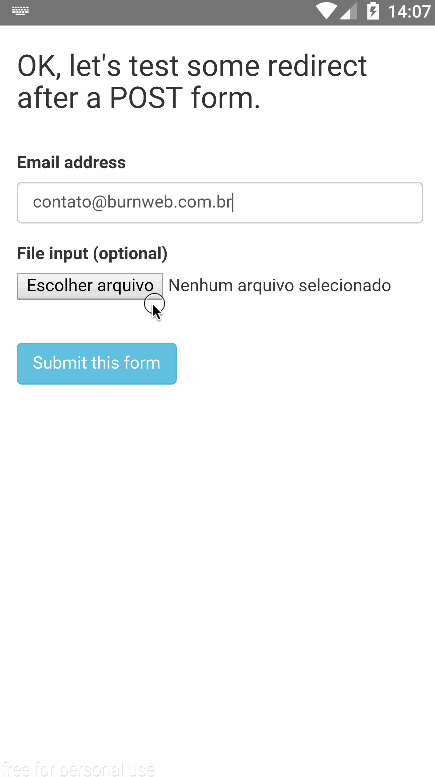
Security News
Oracle Drags Its Feet in the JavaScript Trademark Dispute
Oracle seeks to dismiss fraud claims in the JavaScript trademark dispute, delaying the case and avoiding questions about its right to the name.
react-native-webview-android
Advanced tools
Simple React Native Android module to use Android's WebView inside your app
Simple React Native Android module to use Android's WebView inside your app (with experimental html file input support to handle file uploads in forms).
npm install react-native-webview-android --save
android/setting.gradle...
include ':RNWebView', ':app'
project(':RNWebView').projectDir = new File(rootProject.projectDir, '../node_modules/react-native-webview-android/android')
android/app/build.gradle...
dependencies {
...
compile project(':RNWebView')
}
import com.burnweb.rnwebview.RNWebViewPackage; // <--- import
public class MainApplication extends Application implements ReactApplication {
......
@Override
protected List<ReactPackage> getPackages() {
return Arrays.<ReactPackage>asList(
new MainReactPackage(),
new RNWebViewPackage()); // <------ add this line to your MainApplication class
}
......
}
If you need to see the install instructions for older React Native versions look here.
var React = require('react-native');
var { StyleSheet } = React;
var WebViewAndroid = require('react-native-webview-android');
var SITE_URL = "https://www.google.com";
var WebViewAndroidExample = React.createClass({
getInitialState: function() {
return {
url: SITE_URL,
// OR
// you can use a source object like React Native Webview.
// source {uri: string, method: string, headers: object, body: string}, {html: string, baseUrl: string}
// Loads static html or a uri (with optional headers) in the WebView. <Just like React Native's version>
// source: {
// uri: SITE_URL,
// headers: {
// ...
// },
// },
status: 'No Page Loaded',
backButtonEnabled: false,
forwardButtonEnabled: false,
loading: true,
messageFromWebView: null
};
},
goBack: function() {
// you can use this callback to control web view
this.refs.webViewAndroidSample.goBack();
},
goForward: function() {
this.refs.webViewAndroidSample.goForward();
},
reload: function() {
this.refs.webViewAndroidSample.reload();
},
stopLoading: function() {
// stops the current load
this.refs.webViewAndroidSample.stopLoading();
},
postMessage: function(data) {
// posts a message to web view
this.refs.webViewAndroidSample.postMessage(data);
},
evaluateJavascript: function(data) {
// evaluates javascript directly on the webview instance
this.refs.webViewAndroidSample.evaluateJavascript(data);
},
injectJavaScript: function(script) {
// executes JavaScript immediately in web view
this.refs.webViewAndroidSample.injectJavaScript(script);
},
onShouldStartLoadWithRequest: function(event) {
// currently only url & navigationState are returned in the event.
console.log(event.url);
console.log(event.navigationState);
if (event.url === 'https://www.mywebsiteexample.com/') {
return true;
} else {
return false;
}
},
onNavigationStateChange: function(event) {
console.log(event);
this.setState({
backButtonEnabled: event.canGoBack,
forwardButtonEnabled: event.canGoForward,
url: event.url,
status: event.title,
loading: event.loading
});
},
onMessage: function(event) {
this.setState({
messageFromWebView: event.message
});
},
javascriptToInject: function () {
return `
$(document).ready(function() {
$('a').click(function(event) {
if ($(this).attr('href')) {
var href = $(this).attr('href');
window.webView.postMessage('Link tapped: ' + href);
}
})
})
`
},
render: function() {
return (
<WebViewAndroid
ref="webViewAndroidSample"
javaScriptEnabled={true}
geolocationEnabled={false}
builtInZoomControls={false}
injectedJavaScript={this.javascriptToInject()}
onShouldStartLoadWithRequest={this.onShouldStartLoadWithRequest}
onNavigationStateChange={this.onNavigationStateChange}
onMessage={this.onMessage}
url={SITE_URL} // or use the source(object) attribute...
style={styles.containerWebView} />
);
// other attributes: source(object), html(string), htmlCharset(string), baseUrl(string), injectedJavaScript(string), disableCookies(bool), disablePlugins(bool), userAgent(string)
}
});
var styles = StyleSheet.create({
containerWebView: {
flex: 1,
}
});
This module has a working implementation of onShouldStartLoadWithRequest. However, the event it returns currently only includes url and navigationState.
This module implements an experimental support to handle file input in HTML forms for upload files. It was tested in some Android versions 4.1+, but it's possible that some device won't work OK with that new feature.

To work with some html5 video player inside your Webview, I recommend you to set the android:hardwareAccelerated="true" in your AndroidManifest.xml file.
More info here: http://stackoverflow.com/questions/17259636/enabling-html5-video-playback-in-android-webview
MIT
FAQs
Simple React Native Android module to use Android's WebView inside your app
The npm package react-native-webview-android receives a total of 5 weekly downloads. As such, react-native-webview-android popularity was classified as not popular.
We found that react-native-webview-android demonstrated a not healthy version release cadence and project activity because the last version was released a year ago. It has 1 open source maintainer collaborating on the project.
Did you know?

Socket for GitHub automatically highlights issues in each pull request and monitors the health of all your open source dependencies. Discover the contents of your packages and block harmful activity before you install or update your dependencies.

Security News
Oracle seeks to dismiss fraud claims in the JavaScript trademark dispute, delaying the case and avoiding questions about its right to the name.

Security News
The Linux Foundation is warning open source developers that compliance with global sanctions is mandatory, highlighting legal risks and restrictions on contributions.

Security News
Maven Central now validates Sigstore signatures, making it easier for developers to verify the provenance of Java packages.